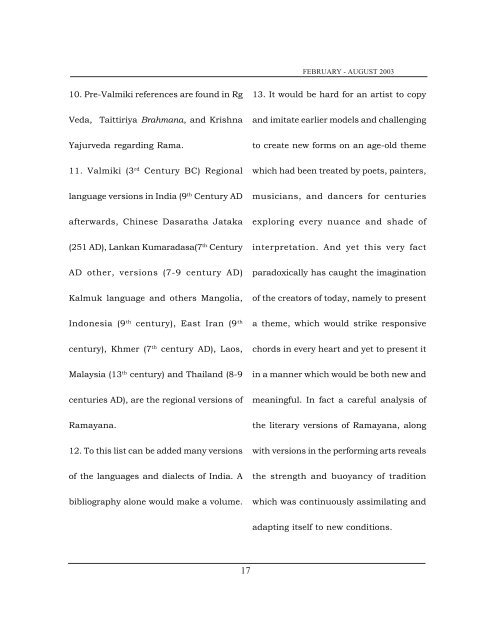Epics in Imprints-1.pdf - Vivekananda Kendra Prakashan
Epics in Imprints-1.pdf - Vivekananda Kendra Prakashan
Epics in Imprints-1.pdf - Vivekananda Kendra Prakashan
Create successful ePaper yourself
Turn your PDF publications into a flip-book with our unique Google optimized e-Paper software.
10. Pre-Valmiki references are found <strong>in</strong> Rg<br />
Veda, Taittiriya Brahmana, and Krishna<br />
Yajurveda regard<strong>in</strong>g Rama.<br />
11. Valmiki (3 rd Century BC) Regional<br />
language versions <strong>in</strong> India (9 th Century AD<br />
afterwards, Ch<strong>in</strong>ese Dasaratha Jataka<br />
(251 AD), Lankan Kumaradasa(7 th Century<br />
AD other, versions (7-9 century AD)<br />
Kalmuk language and others Mangolia,<br />
Indonesia (9 th century), East Iran (9 th<br />
century), Khmer (7 th century AD), Laos,<br />
Malaysia (13 th century) and Thailand (8-9<br />
centuries AD), are the regional versions of<br />
Ramayana.<br />
12. To this list can be added many versions<br />
of the languages and dialects of India. A<br />
bibliography alone would make a volume.<br />
17<br />
FEBRUARY - AUGUST 2003<br />
13. It would be hard for an artist to copy<br />
and imitate earlier models and challeng<strong>in</strong>g<br />
to create new forms on an age-old theme<br />
which had been treated by poets, pa<strong>in</strong>ters,<br />
musicians, and dancers for centuries<br />
explor<strong>in</strong>g every nuance and shade of<br />
<strong>in</strong>terpretation. And yet this very fact<br />
paradoxically has caught the imag<strong>in</strong>ation<br />
of the creators of today, namely to present<br />
a theme, which would strike responsive<br />
chords <strong>in</strong> every heart and yet to present it<br />
<strong>in</strong> a manner which would be both new and<br />
mean<strong>in</strong>gful. In fact a careful analysis of<br />
the literary versions of Ramayana, along<br />
with versions <strong>in</strong> the perform<strong>in</strong>g arts reveals<br />
the strength and buoyancy of tradition<br />
which was cont<strong>in</strong>uously assimilat<strong>in</strong>g and<br />
adapt<strong>in</strong>g itself to new conditions.

















